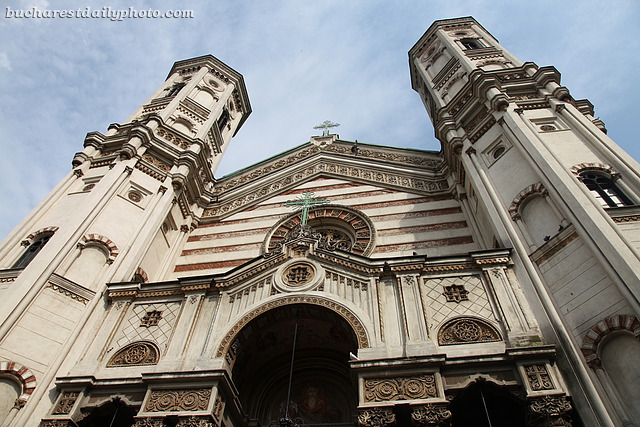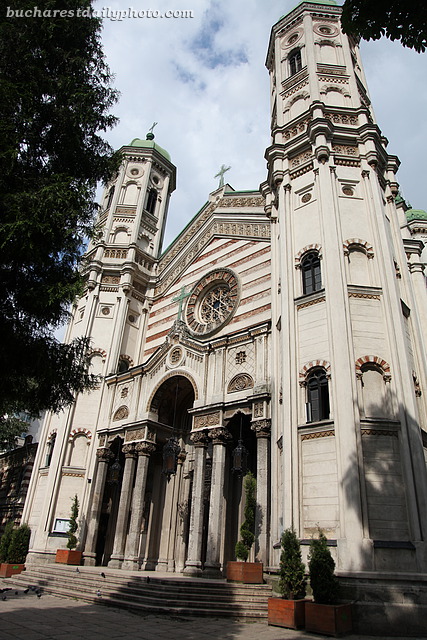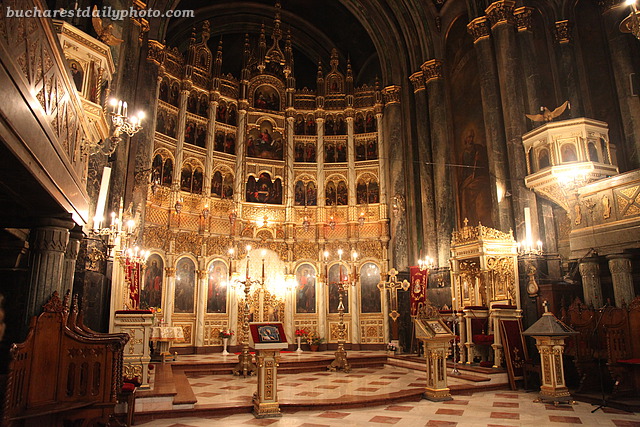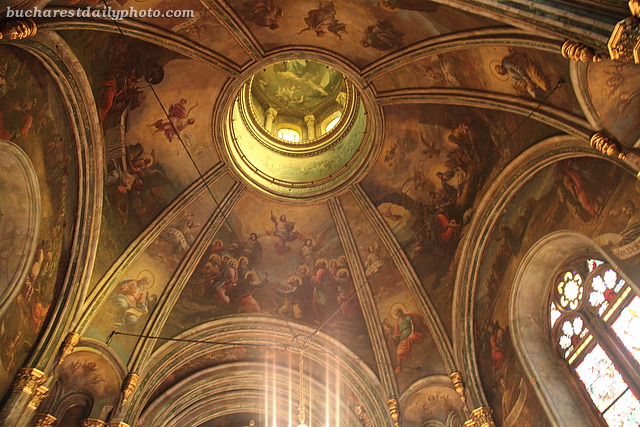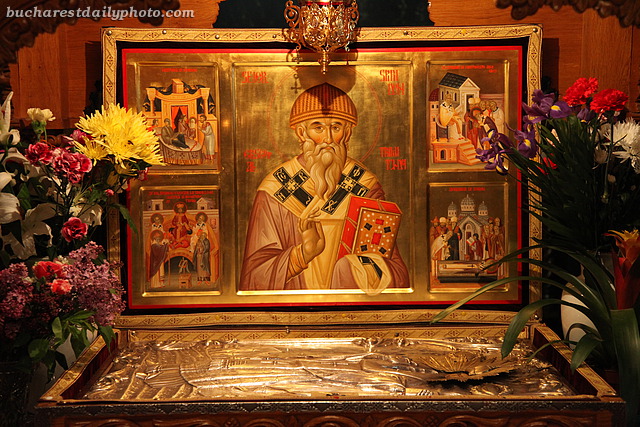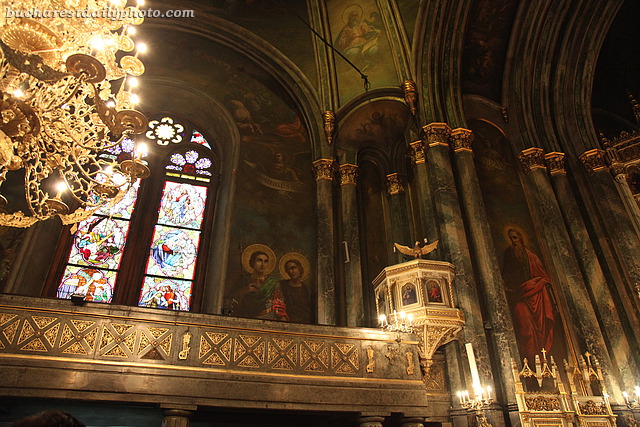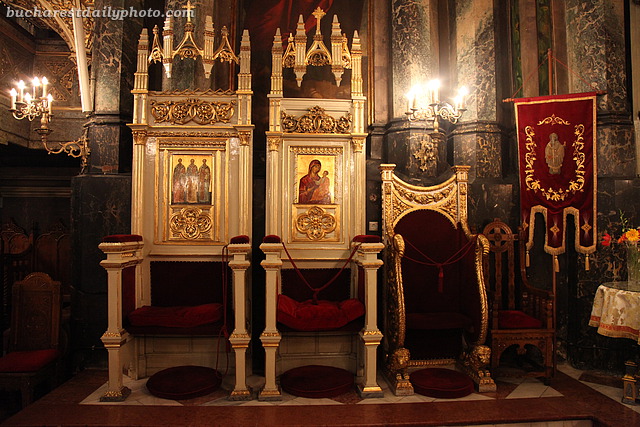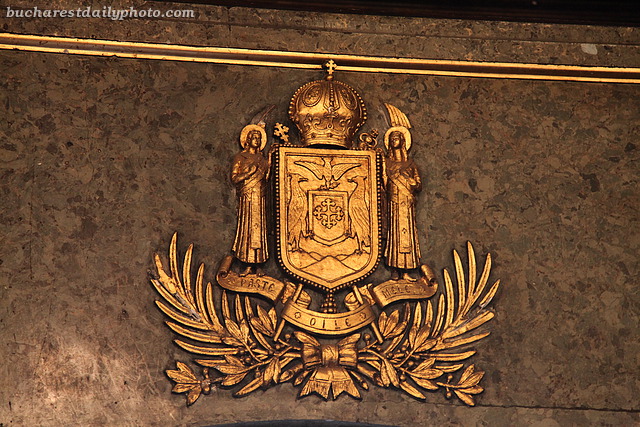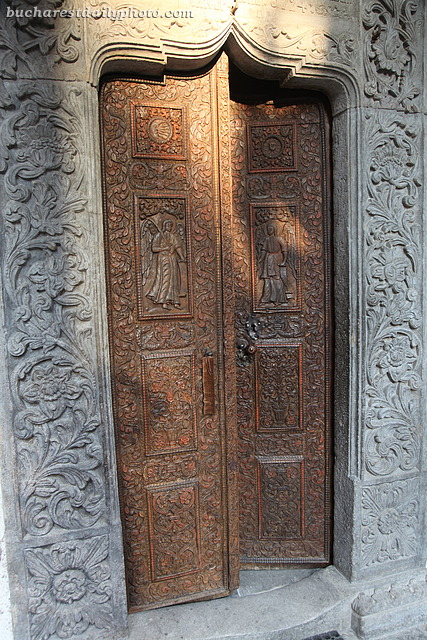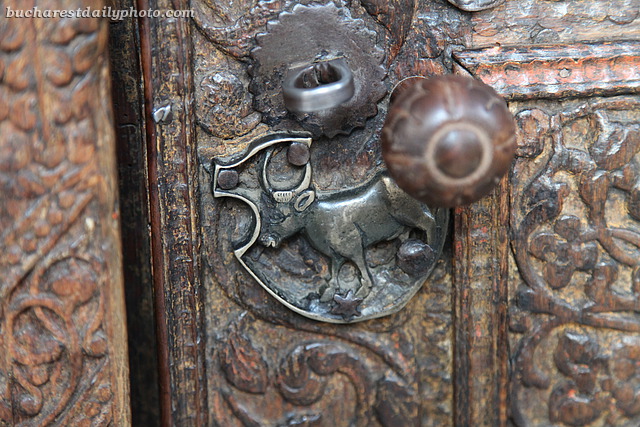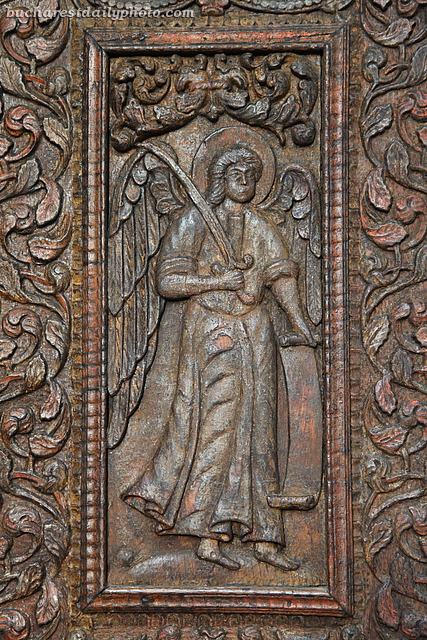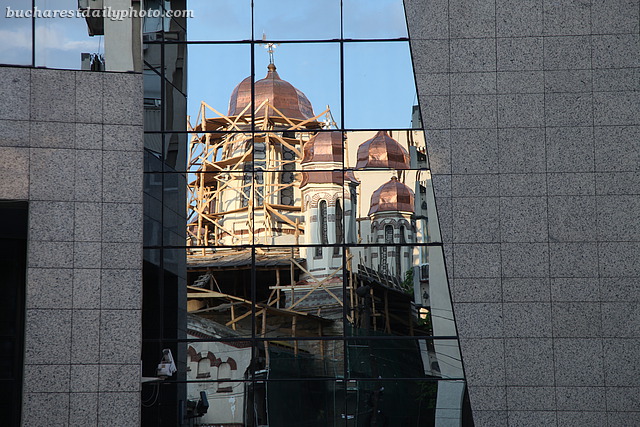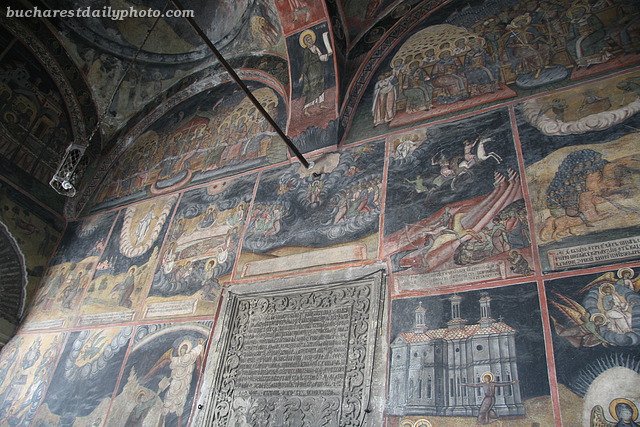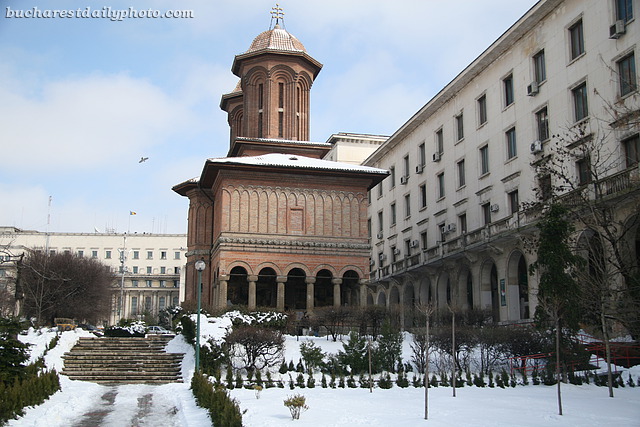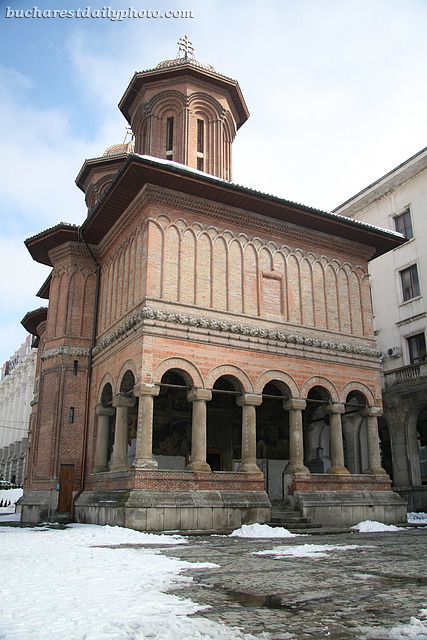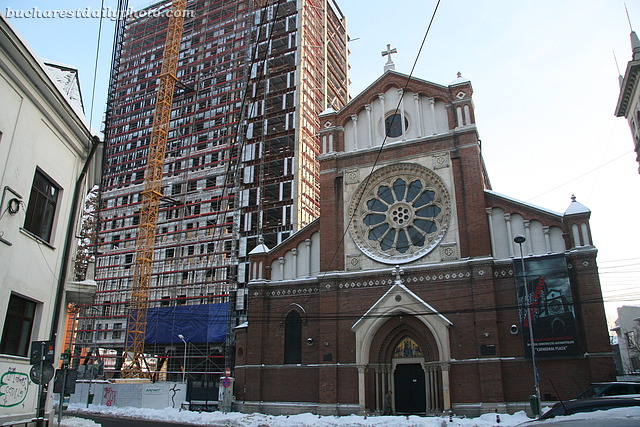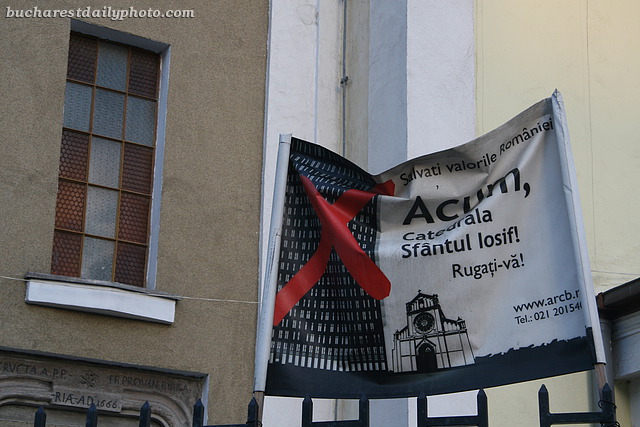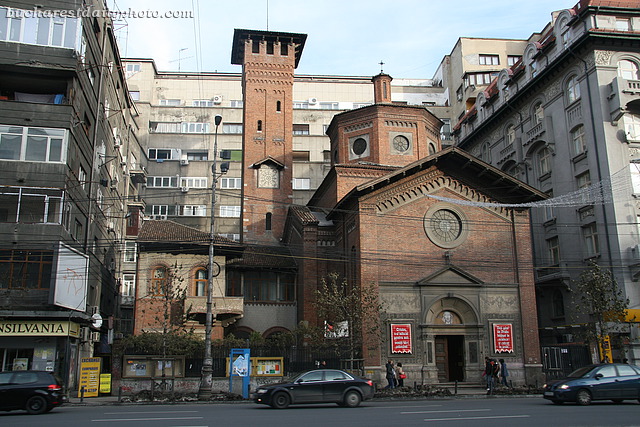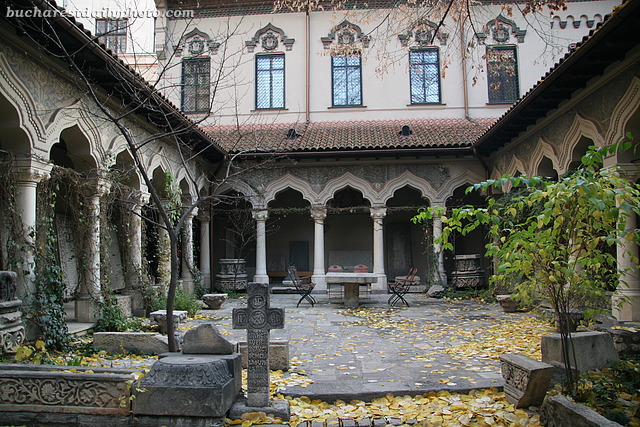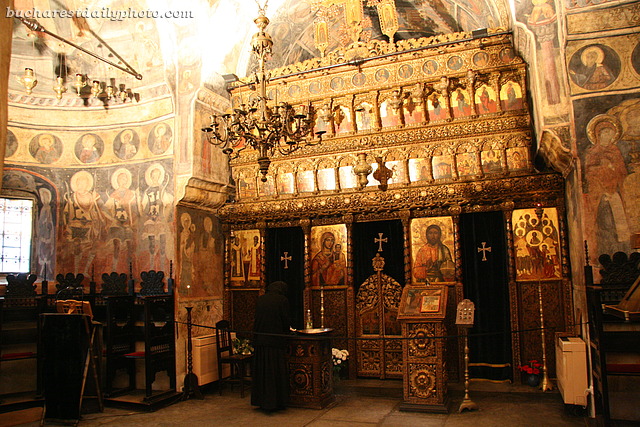Outside views of the church.
Almost a month ago I got invited to attend a wedding and on this occasion I got the chance to photograph another one of Bucharest’s beautiful churches: New Saint Spyridon Church on Calea Şerban Vodă. The church is the biggest orthodox church in Bucharest and I was really impressed by it, not by its size, but by its handsome interior and exterior. The first church by the name New Saint Spyridon Chuch was built on this site in 1766-1768, construction being started by one of Wallachia’s rulers, Scarlat Ghika, and finished by his son Alexandru Ghika. The building lasted until the year 1852 when the church was rebuilt entirely by architects Luigi Lipizer and Xavier Villacrosse, construction ending in 1858. The oil painting was done by Gheorghe Tattarescu in 1862. In the 20th century the church was damaged in the air raids of the WWII (1944), by the 1940 and 1977 earthquakes and by the construction of Bucharest’s subway in 1979 but the highest threat came when the communists decided to demolish it. Happily, the church was saved through the intervention of the former head of the Romanian church, Patriarch Teoctist. The architectural style is Neo-Gothic with traditional Romanian influences.
Zlătari Church reflected in the glass building called Bucharest Financial Plazza, on Victory Road (Calea Victoriei).
On the road and struggling with a slooow Internet connection so I’ll keep it short. Today’s photo shows the beautiful frescoes of the Kretzulescu church’s porch.
Kretzulescu Church aka Creţulescu Church is an Eastern Orthodox Church located on one of the corners of the Revolution Square, by the former Royal Palace. This red brick beauty is one of the oldest churches in Bucharest, being built between 1720-1722 by the boyar Iordache Cretulescu and his wife Safta, a daughter of prince Constantin Brâncoveanu. The church is built in the style created by Constantin Brâncoveanu, a seventeenth century ruler of Wallachia, who commissioned numerous buildings during his reign and set out to create a distinctive national genre of architecture. The exterior of the church was originally painted, but the paint was removed during the 1935-1936 renovations, conducted by architect Ştefan Balş. More renovations were done after the 1977 earthquake and the Revolution of 1989. During the communist regime the church was scheduled for demolition but it was saved through the intervention of architects.
Keeping with the religious theme a while longer, this is Bucharest’s most important catholic church. It was built between the years 1873-1884 after plans by the Austrian architect Friedrich von Schmidt, who also designed Vienna’s City Hall. Its red brick exterior is a blend of Neo Romanesque and Neo Gothic styles, like the rose window and arched portal. It was restored and consolidated after every major earthquake of last century. During his visit to Bucharest in May 1999, Pope John Paul II attended here the Divine Liturgy in the oriental tradition, together with the whole hierarchy of the Greek Catholic Church of Romania. In the last years the church witnessed the development of a 20 floor business center right next door, building which will ironically be called “Cathedral Plaza” even though the church has fiercely opposed the building of the center, citing concerns of structural damage. It is not the first time a new glass office building appears overnight in an area of old houses, with no attention being payed to integrating the buildings architecturally. With the price of land in Bucharest’s center skyrocketing in the last decade and the construction rush that followed we’re bound to see this happening again and again.
Below: A protest banner photographed at another catholic church (Bărăţia) in downtown Bucharest. It reads “Save Romania’s values. Now, Saint Joseph Cathedral! Pray!”
Even if my title didn’t spell it out, I don’t think it would have taken you more than a few seconds to identify this building. The campanile and the Lombard Romanesque style speak for themselves. The Italian Church of the Most Holy Redeemer is a Roman Catholic Church built in 1915-1916 using funds donated by the Vittorio Emanuele III, the Holy See, the Italian Embassy in Bucharest and the Italian community in Romania which in 1915 counted about 7000 people. It is the property of the Italian government and is located on the busiest boulevard in Bucharest, Nicolae Bălcescu. The architects were Mario Stoppa and Giuseppe Furaboschi. The first appointed priest, Antonio Mantica, served here until December 1949 when he was arrested by the communists and forced to live Romania. The newly appointed priest, Clemente Gatti, served until March 1951 when he also was arrested, sentenced to 15 years in prison and later deported. The church was closed until 1968 when it was opened with the occasion of a state visit by the Italian Prime Minister Amintore Fanfani. Following the visit, the church remained open, but only a few services a year were performed, on special occasions like Easter, Christmas, the Assumption of Mary etc. Finally, the Italian Church was reopened in 1989 after the Romanian Revolution. Services are held daily in Romanian, and on Sundays in Romanian, Italian and Polish. The parish house was added in 1924 and for a while served as the Italian school. The campanile is 27.75 meters tall and carries 4 large bells. The surrounding tall buildings were raised in the 1930’s altering the space around the church.
Alongside the church there is a small beautiful yard surrounded by a porticoes on three sides. This building has been added during the restoration done in 1899-1901 by architect Ion Mincu and if you look closely you’ll notice that the porticoes are inspired by the architecture of the church. This building shelters a library with a collection of old manuscripts, a refectory where conferences are held, and a collection of 18th century religious objects, some of them brought here from other churches and monasteries that were demolished in the communist years. The convent’s caretakers also work to restore old books, icons, other liturgical objects and clothes, to translate old books and to transcribe old musical scores digitally. The church is also famous for its choir which sings Byzantine music. I really like the courtyard with its old tombstones and fragments of old sculptures. I’ve seen it in many types of weather, on a sunny morning or under grey skies, when it was snowing or when it was raining and it always looks beautiful and has a peaceful and quiet feel.
In yesterday’s post I was saying that I believe it’s impossible to visit Stavropoleos and not be moved in some way. This feeling will be even stronger at the sight of the church interior. You’ll find the same fresco-covered walls and golden iconostasis found in most Eastern Orthodox churches but somehow they look more exceptional here. If you are Christian you’ll feel like the church interior encourages prayer and meditation. Even the tourists leave their cameras aside and sit quiet on the little benches. The black silhouette that you see in the photo is of one of the nun caretakers who was tending the candles.
